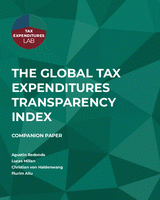Global Tax Expenditures Transparency Index
Books (2023)
Bonn: German Institute of Development and Sustainability (IDOS)
ISBN: 978-3-96021-215-7
DOI: https://doi.org/10.23661/r3.2023
Tax expenditures (TEs) are tax benefits that lower government revenue and the tax liability of the beneficiary. Governments worldwide use TEs to pursue different policy goals such as attracting investment, boosting innovation and mitigating inequality. At the same time, TEs are costly (the global average over the 1990-2022 period is 3.8 percent of GDP and 23.0 percent of tax revenue) and often ineffective in reaching their stated goals. They can sometimes be highly distortive and trigger negative externalities. Yet, despite the fact that TEs have similar effects on public budgets as direct spending, the lack of transparency in the TE field is striking: only 105 out of 218 jurisdictions have reported on TEs at least once since 1990. In addition, the quality, regularity and scope of such reports are highly heterogeneous and, in many cases, do not allow to engage in meaningful discussions on the effectiveness and efficiency of TEs. The Global Tax Expenditures Transparency Index (GTETI) is the first comparative assessment of TEreporting that covers countries worldwide. It provides a systematic framework to rank countries according to the regularity, quality and scope of their TE reports, and seeks to increase transparency and accountability in the TE field. This Companion Paper introduces the GTETI and provides a detailed description of the 5 dimensions and 25 indicators that make up the index. It also discusses the rationale and scope as well as the methodology and assumptions underpinning the GTETI assessment process. The Companion Paper also explains the limitations and issues that the users need to bear in mind when using the index, which is publicly available free of charge on the Tax Expenditures Lab website, www.taxexpenditures.org. Finally, the normative approach behind the GTETI is illustrated in Appendix 1, where a detailed description of an ideal TE report is provided. Appendix 2 contains the GTETI scoring sheet with a detailed list of all indicators and the required supporting documentation.


